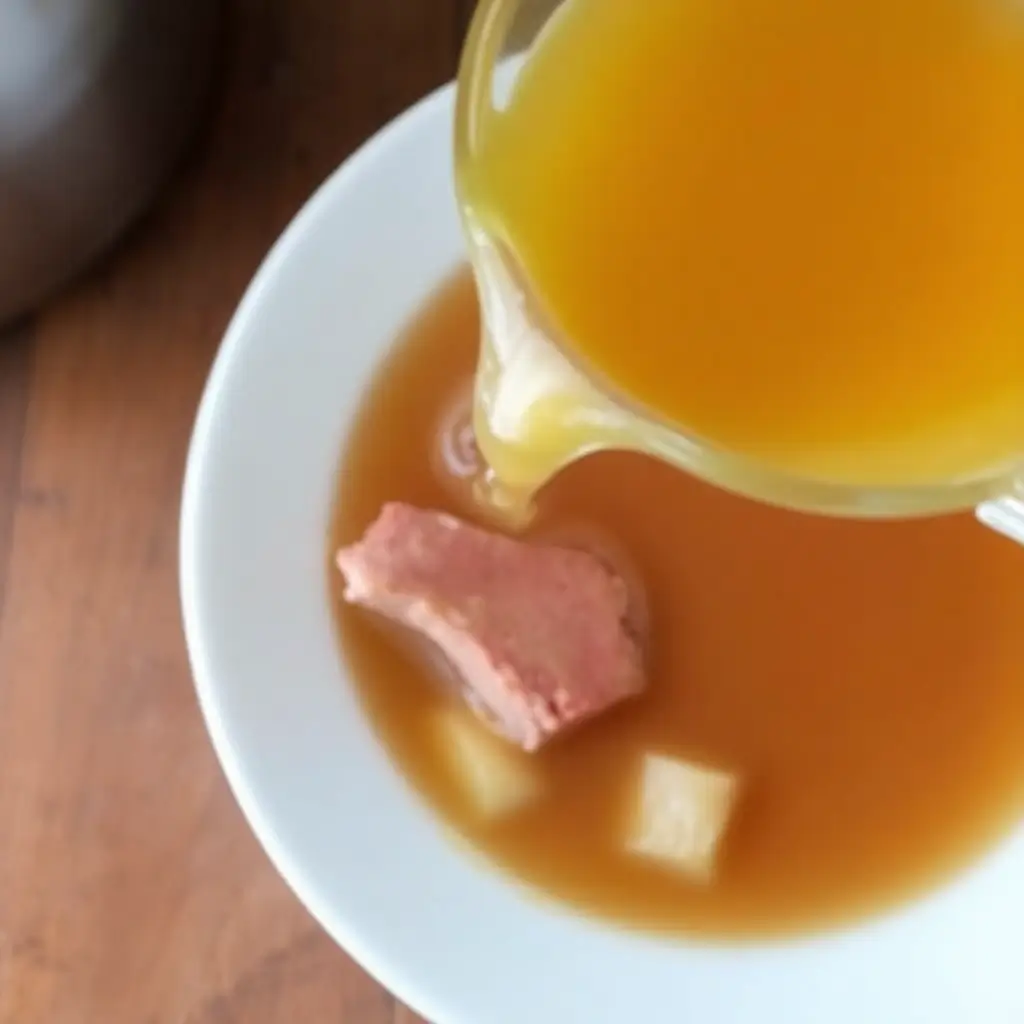There’s something magical about a hot bowl of bone broth. It’s not just comfort food—it’s a powerhouse of nutrients that’s been cherished for hundreds of years. Whether you’re sipping it directly from the cup or adding it to soups, stews, or gravies, beef bone broth is both tasty and wholesome. But how do you make it at home? Well, let’s dive in

What is Beef Bone Broth?
Beef bone broth is more than just a liquid. In fact, it’s a concentrated, savory brew made by simmering beef bones (sometimes with meat still attached) for hours. As the bones slowly simmer, they break down collagen and release marrow, minerals, and nutrients. Consequently, the result is a rich, golden elixir that not only adds depth to your food but also nurtures your body.
While you can drink it directly, it’s also the base for so many delicious dishes—soups, risottos, sauces, and gravies. Therefore, it’s versatile, nutritious, and easy to make.
Health Benefits
Now, let’s talk about the good stuff. Beef bone broth is packed with collagen, a protein that supports skin elasticity, joint health, and much more. Your skin will love it—goodbye, fine lines! Furthermore, your joints will feel smoother and less creaky. Additionally, bone broth also helps heal your gut, boosting digestion and fighting inflammation.
Moreover, it’s excellent for your immune system. All those minerals from the bones—calcium, magnesium, and phosphorus—work together to keep your body strong and healthy.
Beef Broth vs. Beef Stock
So, beef broth and beef stock—what’s the difference? Many people use these terms interchangeably, but there are subtle differences.
Preparation: Beef broth is made with meaty bones and simmered for about 2-4 hours. It’s lighter, faster, and less rich. Beef stock, however, uses a wider variety of bones and simmers for 6-12 hours. As a result, it’s thicker, richer, and typically gel-like when cooled because of the gelatin from the bones.
Nutritional Value: Both provide excellent benefits, but stock generally has more gelatin (which is great for joints and digestion). Beef broth, being lighter, is gentler on the stomach and faster to make.
The Best Beef Bones for Broth
Types of Bones to Use
Not all bones are created equal. To get the best beef bone broth, you need to choose the right bones. Here are your top options:
- Marrow Bones: These are fatty and rich in marrow. Roasting them brings out deep, hearty flavors.
- Knuckle Bones : Girl
- Oxtail: Full of collagen and marrow, oxtail is another excellent choice. It creates a flavorful, nutrient-dense broth that’s perfect for hearty meals.
Why Choose Grass-Fed or Organic Bones?
It’s tempting to grab any bones off the shelf, but choosing grass-fed or organic bones makes a world of difference. Grass-fed beef is richer in omega-3s and antioxidants. Additionally, organic bones come from cows raised without antibiotics or hormones. As a result, this means fewer chemicals in your food and more nutrients in your broth. Organic beef bones are considered the gold standard, offering the best flavor and health benefits.

Where to Buy Beef Bones
Finding quality beef bones can be easy if you know where to look. Here are your best options:
- Butcher Shops: The local butcher is an excellent resource. You can often find fresh, high-quality bones and even ask for specific kinds like knuckle or marrow bones.
- Local Farms: If you’re lucky enough to have local farms nearby, they may sell beef bones. They often provide pasture-raised options, which are better for your health and the environment.
- Online: If you can’t find bones locally, don’t worry. There are plenty of online shops that sell organic, grass-fed beef bones. Just make sure to read the reviews and choose a trusted supplier.
How to Make Beef Bone Broth (Step-by-Step)

Making beef bone broth is simple, but it does require patience. Here’s how to do it right:
Preparing the Bones
First things first—prep your bones. You have two options here:
- Roasting: Roasting bones enhances the flavor. Spread them out on a baking sheet, drizzle with a bit of olive oil, and roast at 400°F for 30-45 minutes. The result is a beautifully caramelized, rich broth.
- Raw Bones: If you prefer a more delicate flavor, you can skip the roasting. Simply toss the raw bones into your pot and get ready to cook.
Adding Vegetables and Seasonings
A great broth isn’t just about bones—it’s about layers of flavor. Add vegetables and seasonings:
- Onions: Roasted or raw, onions bring sweetness to the broth.
- Garlic: Adds depth and a little kick.
- Bay Leaves: A subtle herbal note that rounds everything out.
- Peppercorns: For a touch of warmth.
You can get creative with herbs too—throw in some rosemary, thyme, or parsley for extra flavor.
Simmering the Bones
Now, it’s time to cook. Whether you’re simmering on the stovetop, in a slow cooker, or using a pressure cooker, the goal is to extract all of the goodness from the bones:
- Stovetop: Bring your broth to a boil, then reduce the heat to a simmer. Let it cook for 4-12 hours (the longer, the better).
- Slow Cooker: Set your slow cooker on low for 12-24 hours. This hands-off approach produces a rich, flavorful broth without much effort.
- Pressure Cooker: Short on time? The pressure cooker can cut down cooking time to just 2-3 hours while still extracting all of the vitamins and flavor.
Tips for Using a Slow Cooker or Pressure Cooker
Both methods have their advantages:
- Slow Cooker: The slow simmer allows all the collagen and minerals to leach out, creating a thick, full-bodied broth. Plus, it’s nearly set-it-and-forget-it.
- Pressure Cooker: For those in a hurry, the pressure cooker gets the job done quickly while still preserving the essence of traditional bone broth. It’s efficient, but still gives you a nutrient-dense broth.
Bone Broth vs. Stock: What’s the Difference?
Key Differences in Ingredients and Preparation
Bone broth and stock share similarities, but they have key differences. Bone broth tends to be lighter and uses meaty bones, while stock uses a wider variety of bones and simmers for longer.
Nutritional Benefits Comparison
Both are rich in nutrients, but bone broth is usually higher in collagen and gelatin, making it the better choice for joint health and skin rejuvenation.
Which is Better for Health?
If you’re looking for collagen-rich broth for your skin, joints, and digestion, bone broth is your best bet. It’s also ideal for those following Paleo or Keto diets due to its high protein and low carb content.
Storing and Using Beef Bone Broth
How to Store Beef Bone Broth
After all that work, you’ll want to store your broth properly:
- Refrigerating: For short-term storage, refrigerate in an airtight container for 3-4 days.
- Freezing: For long-term storage, pour your cooled broth into ice cube trays or freezer-safe containers. It can last up to 6 months when frozen.
Creative Ways to Use Beef Bone Broth
Bone broth isn’t just for drinking—it’s versatile. Here are some ways to get the most out of it:
- Soups & Stews: The perfect base for your favorite comfort foods.
- Gravies: Make rich, flavorful gravies easily.
- Cooking Grains: Replace water with broth when cooking rice or quinoa for added richness.
Daily Health Benefits of Bone Broth
Drinking bone broth every day can work wonders:
- Skin: Collagen promotes smooth, youthful skin.
- Hair: Healthy, shiny hair benefits from the amino acids in bone broth.
- Joints: Collagen helps maintain joint health and flexibility.
- Gut: Gelatin soothes the digestive system, aiding with gut issues.
Conclusion
Making beef bone broth at home is simple, and the benefits are enormous. You’ll have a delicious, nutrient-packed broth ready to enhance your meals and support your health. So, it’s time to start making your own!
Grab some great beef bones, follow the steps, and enjoy the deliciousness!
Start your broth-making journey today—your body will thank you!
